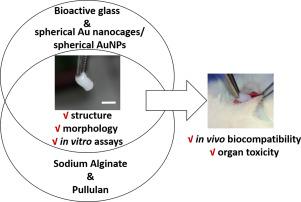Biomaterials Advances ( IF 5.5 ) Pub Date : 2021-03-03 , DOI: 10.1016/j.msec.2021.112006 Alexandra Dreanca , Marieta Muresan-Pop , Marian Taulescu , Zsejke-Réka Tóth , Sidonia Bogdan , Cosmin Pestean , Stephie Oren , Corina Toma , Andra Popescu , Emőke Páll , Bogdan Sevastre , Lucian Baia , Klara Magyari

|
Biomaterials based on bioactive glass with gold nanoparticle composites have many applications in tissue engineering due to their tissue regeneration and angiogenesis capacities. The objectives of the study were to develop new composites using bioactive glass with gold nanospheres (BGAuSP) and gold nanocages (BGAuIND), individually introduced in alginate-pullulan (Alg-Pll) polymer, to evaluate their biocompatibility potential, and to compare the obtained results with those achieved when β-tricalcium phosphate-hydroxyapatite (βTCP/HA) replaced the BG. The novel composites underwent structural and morphological characterization followed by in vitro viability testing on fibroblast and osteoblast cell lines. Additionally, the biomaterials were subcutaneously implanted in Sprague Dawley rats, for in vivo biocompatibility assessment during 3 separate time frames (14, 30 and 60 days). The biological effects were evaluated by histopathology and immunohistochemistry. The physical characterization revealed the cross-linking between polymers and glasses/ceramics and demonstrated a suitable thermal stability for sterilization processes. The in vitro assays demonstrated adequate form, pore size of composites ranging from few micrometers up to 100 μm, while the self-assembled apatite layer formed after simulated body fluid immersion confirmed the composites' bioactivity. Viability assays have highlighted optimal cellular proliferation and in vitro biocompatibility for all tested composites. Furthermore, based on the in vivo subcutaneous analyses the polymer composites with BGAuNP have shown excellent biocompatibility at 14, 30 and 60 days, exhibiting marked angiogenesis while, tissue proliferation was confirmed by high number of Vimentin positive cells, in comparison with the polymer composite that contains βTCP/HA, which induced an inflammatory response represented by a foreign body reaction. The obtained results suggest promising, innovative, and biocompatible composites with bioactive properties for future soft tissue and bone engineering endeavours.
中文翻译:

生物活性玻璃-生物聚合物-金纳米颗粒的复合材料,用于组织工程应用
基于生物活性玻璃和金纳米颗粒复合材料的生物材料由于其组织再生和血管生成能力而在组织工程中具有许多应用。这项研究的目的是使用生物活性玻璃与金纳米球(BGAuSP)和金纳米笼(BGAuIND)开发新的复合材料,分别将其引入藻酸盐-普鲁兰(Alg-Pll)聚合物中,以评估其生物相容性潜力,并比较所得的复合物。用β-磷酸三钙-羟基磷灰石(βTCP/ HA)代替BG所获得的结果。对新型复合材料进行结构和形态表征,然后在成纤维细胞和成骨细胞系上进行体外生存力测试。此外,将生物材料皮下植入Sprague Dawley大鼠中,用于在3个不同的时间范围(14、30和60天)内进行体内生物相容性评估。通过组织病理学和免疫组织化学评估生物学作用。物理特征揭示了聚合物与玻璃/陶瓷之间的交联,并显示了适合灭菌过程的热稳定性。在体外测定中表现出足够的形式,复合材料范围从几微米到100微米的孔尺寸,而模拟体液浸没后形成的自组装磷灰石层证实了复合物的生物活性。活力测定法突出了所有测试复合材料的最佳细胞增殖和体外生物相容性。此外,基于体内皮下分析含BGAuNP的聚合物复合物在14、30和60天时表现出优异的生物相容性,表现出明显的血管生成,而与Visinin阳性细胞相比,与含有βTCP/ HA的聚合物复合物相比,大量的波形蛋白阳性细胞证实了组织的增殖以异物反应为代表的炎症反应。获得的结果表明,具有希望用于未来软组织和骨骼工程的具有生物活性的复合材料具有广阔的前景。









































 京公网安备 11010802027423号
京公网安备 11010802027423号